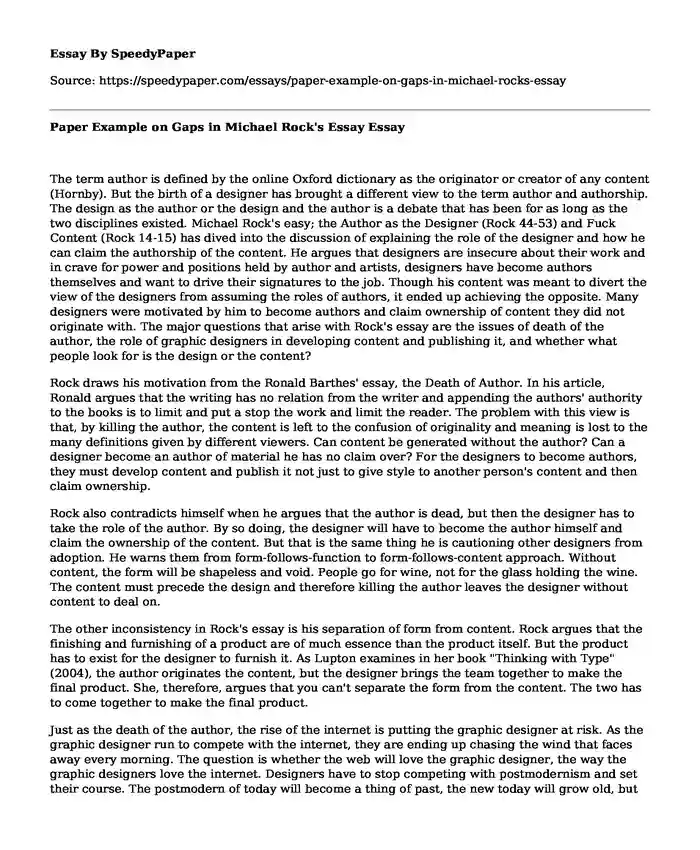
| Type of paper: | Essay |
| Categories: | Writing Design Personality |
| Pages: | 3 |
| Wordcount: | 724 words |
The term author is defined by the online Oxford dictionary as the originator or creator of any content (Hornby). But the birth of a designer has brought a different view to the term author and authorship. The design as the author or the design and the author is a debate that has been for as long as the two disciplines existed. Michael Rock's easy; the Author as the Designer (Rock 44-53) and Fuck Content (Rock 14-15) has dived into the discussion of explaining the role of the designer and how he can claim the authorship of the content. He argues that designers are insecure about their work and in crave for power and positions held by author and artists, designers have become authors themselves and want to drive their signatures to the job. Though his content was meant to divert the view of the designers from assuming the roles of authors, it ended up achieving the opposite. Many designers were motivated by him to become authors and claim ownership of content they did not originate with. The major questions that arise with Rock's essay are the issues of death of the author, the role of graphic designers in developing content and publishing it, and whether what people look for is the design or the content?
Rock draws his motivation from the Ronald Barthes' essay, the Death of Author. In his article, Ronald argues that the writing has no relation from the writer and appending the authors' authority to the books is to limit and put a stop the work and limit the reader. The problem with this view is that, by killing the author, the content is left to the confusion of originality and meaning is lost to the many definitions given by different viewers. Can content be generated without the author? Can a designer become an author of material he has no claim over? For the designers to become authors, they must develop content and publish it not just to give style to another person's content and then claim ownership.
Rock also contradicts himself when he argues that the author is dead, but then the designer has to take the role of the author. By so doing, the designer will have to become the author himself and claim the ownership of the content. But that is the same thing he is cautioning other designers from adoption. He warns them from form-follows-function to form-follows-content approach. Without content, the form will be shapeless and void. People go for wine, not for the glass holding the wine. The content must precede the design and therefore killing the author leaves the designer without content to deal on.
The other inconsistency in Rock's essay is his separation of form from content. Rock argues that the finishing and furnishing of a product are of much essence than the product itself. But the product has to exist for the designer to furnish it. As Lupton examines in her book "Thinking with Type" (2004), the author originates the content, but the designer brings the team together to make the final product. She, therefore, argues that you can't separate the form from the content. The two has to come together to make the final product.
Just as the death of the author, the rise of the internet is putting the graphic designer at risk. As the graphic designer run to compete with the internet, they are ending up chasing the wind that faces away every morning. The question is whether the web will love the graphic designer, the way the graphic designers love the internet. Designers have to stop competing with postmodernism and set their course. The postmodern of today will become a thing of past, the new today will grow old, but the graphic design which is coined on rules and disciplines will remain.
Works cited
Hornby, Albert Sydney, Anthony Paul Cowie, & Alfred Charles Gimson Oxford Advanced Learner's Dictionary of Current English. Vol. 1428. Oxford: Oxford University Press, 1974.
Lupton, Ellen. Thinking with Type: A Critical Guide for Designers, Writers, Editors, & Students. Chronicle Books, 2014. Retrieved from https://designopendata.files.wordpress.com/2014/05/thinkingwithtype_ellenlupton.pdf
Rock, Michael. "Fuck Content." Graphic Design: Now in Production. Minneapolis, MN: Walker Art Center (2011): 14-15 Retrieved from https://2x4.org/ideas/2/fuck-content/
Rock, Michael. "The Designer as Author." Eye 20.5 (1996): 44-53. Retrieved from www.eyemagazine.com/feature/article/the-designer-as-author
Cite this page
Paper Example on Gaps in Michael Rock's Essay. (2023, Jan 23). Retrieved from https://speedypaper.com/essays/paper-example-on-gaps-in-michael-rocks-essay
Request Removal
If you are the original author of this essay and no longer wish to have it published on the SpeedyPaper website, please click below to request its removal:
- Who Is to Blame for Macbeth's Downfall? A Literary Essay Sample
- Therapeutic Alliance and Child Abuse, Free Essay in Psychology
- Why Banks Fail - Our Free Paper Sample Provides an Answer
- Heart of Darkness, Literary Analysis Essay Sample
- Essay Example on TEC and ERP Systems
- Essay Example Dedicated to the Migration and Its Effects in Zimbabwe
- Essay Sample on Manual Repositioning Strategies
Popular categories




